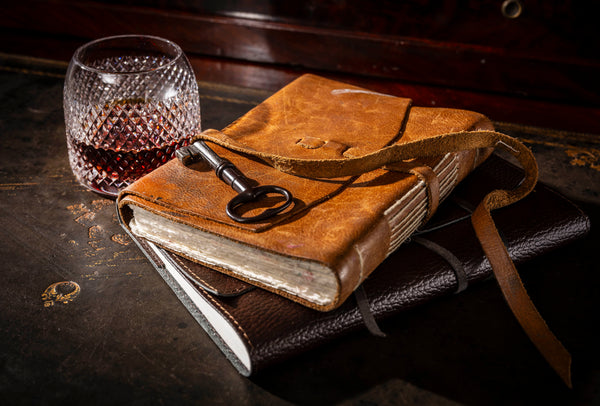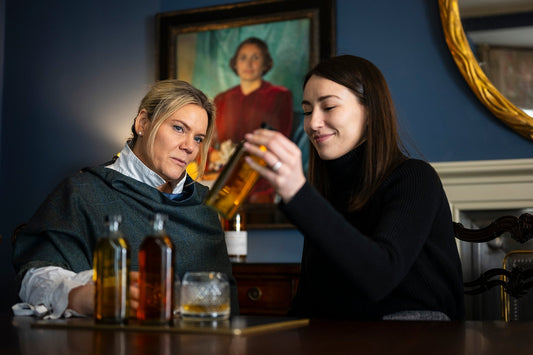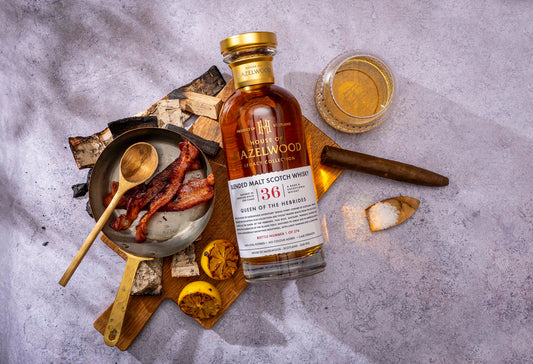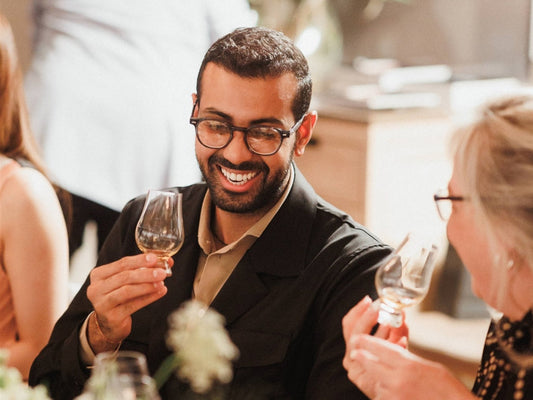Forging the career of a lifetime as a coppersmith and guardian. We speak to Dennis McBain, one of the industry’s first in-house coppersmiths.
For almost 100 years, the Gordon Family has been carefully laying down stocks of Scotch Whisky, left to slumber for over half a decade at a time. Over this time, a chosen few whisky craftsmen have assumed the role of guardianship, overseeing each part of the process with the due diligence and care such exceptional whisky deserves. One such individual is Dennis McBain, a stalwart of the whisky industry, who has been of great influence in caring for the House of Hazelwood as it is today.
Joining the company in 1958, Dennis’s career led to close working relationships with House of Hazelwood pioneers, Charles and Sandy Gordon. From driving innovation in an industry-first as an in-house coppersmith, to adventuring through the remote and rural land of the Cabrach, this Speyside-local has many stories to share.
The Career of a Coppersmith
Dennis, you have accrued almost 65 years as a coppersmith – considered over two lifetimes for some. How did it all begin?
I joined the industry in 1958. I was the old guy – I’m still the old guy! I started in the company when I was 16 years old. Before joining, I’d tried my hand coopering at Speyside Cooperage, but it was a bit too monotonous for me. Although, I suppose I still ended up hammering for a living in the end with copper-smithing. I loved being able to make stills and shape them – it involved a bit more creativity. I was always attracted to the whisky industry – and specifically working with the Gordon family – my father used to always say how good a family company they were to work for.
Your father also worked in the whisky industry too, didn’t he?
Yes, my father and my great uncle. I have a great photograph from 1925 of them together, taken in the Cabrach. I wasn’t the only one to work in whisky – three of my brothers also joined the company working various production roles, although they all stayed for relatively short times compared to me – three, four years or so.
When you started your career in the late 1950s, the landscape in the whisky industry was quite different to how it is now. What was that like?
It was tough, hard work in those days. But everybody just mucked in and got the job done. It was tough, manual work, but there was always great teamwork. Standards were also very high, everything you did had to be perfect – that quality ran across every part of the process – you took great pride in your work.
You’re not as hands on now which I think loses something. Automation and computerisation have lost some of that human intuition and for me personally, that’s not as satisfying. But, it’s just the way things go – it’s progress.
I was brought up to respect the family and the company – they were paying my wages, so it was only right you had respect for the job. If anything went wrong and you were available, you were expected to go and help. Our job was to keep the whisky running in the spirit safe. Do the best you are capable of – it was the doctrine back then.
It's something I still take pride in today – I remember Ian Miller (former distillery manager) telling me after one of my stills had reached the end of its days that it had produced over 10 million litres of whisky.
At the time you joined, the brothers Charles and Sandy Gordon had just come into the business. Their ways of working were quite different to their predecessors and really shook up the industry. What was that like for you?
I joined at a time where there was a huge amount of change taking place in the industry. Production had doubled across the Speyside distilleries – and you noticed the difference in production. We had to employ more people and malting – which is where I worked briefly before becoming a coppersmith – had to even cease production in 1962 because we couldn’t keep up with the increase. The barns were eventually shut down and storage bins were built for purpose elsewhere.
Mr. Charles and Sandy were very knowledgeable – they knew the business inside out and things really started to move. They wanted to be more independent, and you could see it in their work – with Girvan getting built and the increase in production.
And it was this independence from Charles and Sandy Gordon that led to the creation of your role, wasn’t it?
Mr Charles had come into the company earlier and he decided rather than depend on external contractors and companies, he’d focus on becoming independent. This included the maintenance work; he employed an engineer and as well as a coppersmith.
The Coppersmith he employed was man called Willie McLaughlin who he headhunted from a local copper-smithing company. I had been working in malting for nine months and then I was offered the opportunity to assist Willie on small jobs. After around two years, Willie convinced Mr Charles that we could make our own stills. So, we were given a former drying plant as a workplace, we adapted it and we took on a couple of coppersmiths and did our own copper works right up until 1972. I think we were the only whisky producer to ever have resident coppersmiths on site.
Why such independence when it wasn’t the norm across the industry?
His thinking was if there was a breakdown, then he’d have to wait for a contractor to come out to help which could take a while, whereas with this internal approach you had the people on site. It was all about making as much whisky as you can.
It was about long-time thinking – Mr Charles was well ahead of his time in my opinion – he allowed people to experiment under this independence.
You worked closely with Charles and Sandy Gordon because of your role. What were they like?
The family came from normal working background – there was no snobbery or any of that carry on. You could relate to Charles and Sandy’s work ethics – they were owners, but I could talk to them like I would to you – there was no “them versus us.” The very fact they visited the site and talked to you made you feel a bit special – the owner stopping by. It was a two-way thing – they respected the craft.
Mr Charles would walk about the site and if he met you and didn’t know who you were, he’d ask what you do for the company. He’d often ask questions, and everyone was surprised by his knowledge. He knew his workers and site better than most people, I think.
Sandy wasn’t quite so inquisitive – but he’d still ask questions. If you didn’t know, you couldn’t blag it – you had to be straight with him – you couldn’t fool him or pull the wool over his eyes. You had to be honest – even if you didn’t know the answer.
They complimented each other – Charles was a driving force that got things done. Mr Sandy got things done too, but he was more discreet, whereas Charles was more head on.
You perhaps came to know Charles Gordon better than most too, didn’t you?
I remember one day back when Ian Miller was in charge, he came to me and asked me to go to Aberdeen airport to pick up and drive one of the family members to Speyside. I instantly told him “no way”, but Ian was very persuasive and that was the beginning of it.
I did all the driving for Mr. Charles – driving everywhere from central Scotland to Girvan. We spent a lot of time in The Cabrach, conducting research into the origins of the family. My family are from the Cabrach, so I was able to make some introductions, but we never did manage to get to the bottom of the Cabrach’s history with illicit distilling. I got to know Mr. Charles personally with the driving – he was a very witty man!
Of course, today you are now retired and take on only select jobs. Much like the family, there was an element of succession in your role, wasn’t there?
Yes, a guy called George Singer took over from me. He was recruited because of his capabilities using stainless steel – the ideal candidate as copperworks is very similar. We don’t make the stills anymore, so we took him to Forsyth’s to learn – and he’s now more up to date than me!
The craft hasn’t changed a lot though, apart from a bit of modern technology on the welding side. The process is still the same – get the copper red-hot, put it into shape and so on. You need to have a bit of vision of what you’re going to end up with – it makes things so much easier. People think it’s just hitting copper with a wooden mallet but there’s a system to it. You’ve got to watch what you’re doing. It’s a craft.
In your retirement, do you miss it?
You never really leave!




